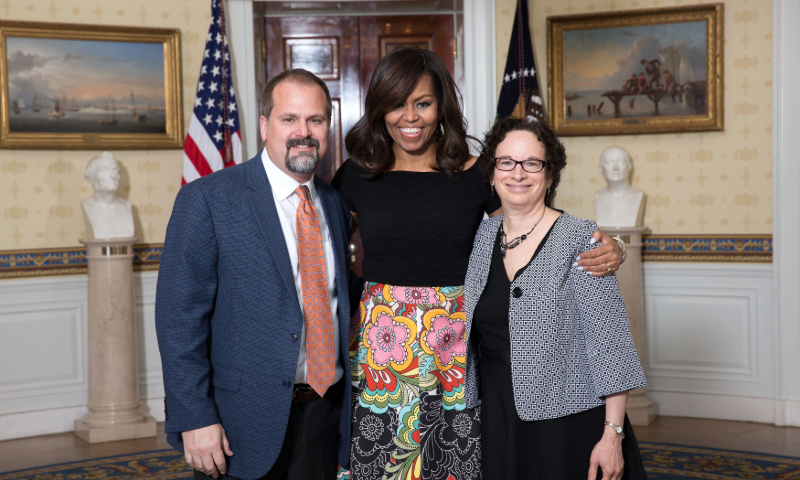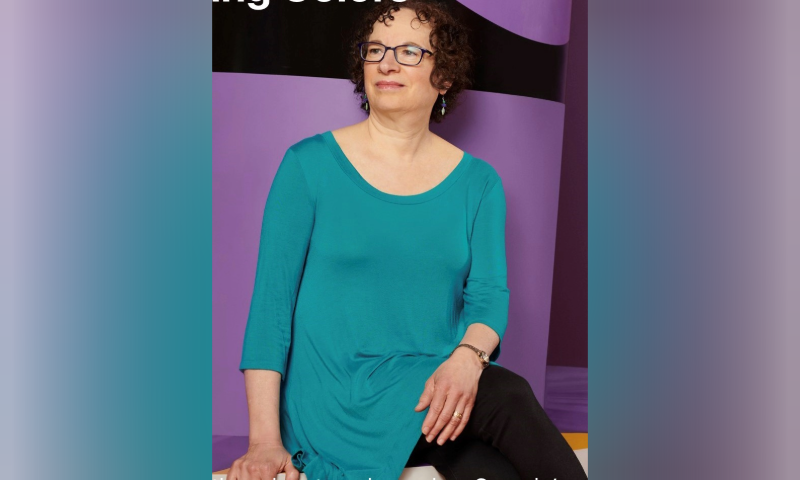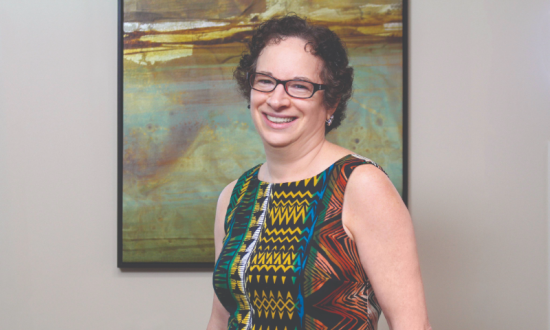Cheri Sterman helps educators and community leaders expand their creative thinking. She provides professional learning courses and podcasts on Creative Leadership, Culturally Responsive Teaching, and The Power of Art to Reverse Stereotypes. Cheri hosts the Crayola monthly online programs including: Creative Spa for Educators, The Art of Learning, and Read Along-Draw Along where she interviews authors, illustrators, art therapists, and educators. Cheri is excited to share information about Crayola Creativity Week, a global celebration of creativity that features celebrity actors and NASA leaders to help 7 million kids in 100 countries around the world see the power of creativity.
Recently, in an exclusive interview with K12 Digest, Cheri shared her professional trajectory, insights on how creativity boosts learning and prepare students for life beyond school, significant career milestones, biggest stress relievers, future plans, pearls of wisdom, and much more. The following excerpts are taken from the interview.
Hi Cheri. Could you please briefly tell us about your background and areas of interest?
Creativity has been the consistent focus throughout my career. As a grad student, my thesis was based on creativity research I conducted with young children, looking for associative fluency measures that document the steady stream of innovative thoughts children share when given the opportunity. We found that all the arts (visual, drama, dance, etc.) impacted the fluency and originality of children’s ideas. I taught college students at the University of Cincinnati and Sinclair College in Ohio and urged them to focus on creative teaching and learning practices. Coming to work at Crayola, the most colorful place on the planet, was a dream come true that I still treasure 37 years after I first joined the organization.
What do you love the most about your current role?
I love the many varied opportunities this job provides. My original position at Crayola was Director of Child Development, and the CEO who hired me asked that I avoid becoming like the many business leaders he had working for him who focused on marketing and sales. Instead he said I should totally focus on helping people understand what kids need and want. Now, as the company’s Director of Education, I still have that same focus. I help Crayolians develop experiences, products, and content that is developmentally appropriate and nurtures creativity. Beyond collaboration inside Crayola, this role has allowed me to help nonprofit organizations, policy makers, and thought leaders develop programs that help kids. For example, I helped Michelle Obama with her President’s Committee for the Arts and Humanities Turn Around Arts Initiative by providing professional learning courses on creativity for their teachers. The schools we trained had their culture and curriculum turned around by Arts Integration. The student learning results were impressive (math scores increased 22.5% and reading scores went up 12.6%). I’ve presented congressional testimony on the Power of Creativity and served on the boards of the Partnership for 21st Century Learning, the National Association for the Education of Young Children, and the National Child Development Council—which enabled me to impact policy recommendations and spread the word about creativity. Crayola has held many advocacy events where I’ve helped put the spotlight on why creativity matters and how we can nurture it in the next generation of innovators and communicators.
How does creativity boost learning and prepare students for life beyond school?
There is a robust body of evidence that creativity is an essential life skill that can be taught and must be nurtured. Having a creative mindset is essential in every career. People who have creative confidence are more satisfied on the job, no matter what field they work in. The good news is that creative behaviors (being curious, keeping an open mind, and seeking new opportunities) can be nurtured during simple, everyday creative moments at home and school. Some ask, “Does drawing really improve outcomes for kids?” Yes! Neuroscientists have found that drawing is THE most effective learning strategy. Lessons that incorporate students drawing result in deeper understanding and the information becomes embedded into the learner’s memory.

What are some of the greatest achievements in your career to date? What makes them special?
Launching Crayola Creativity Week is the most significant achievement in my career. Having led the team that created this program from scratch and knowing how much growth potential there is to reach every child on the planet is professionally and personally gratifying. Your readers can join this global celebration of creativity that occurs every January and provides benefits year-round. Crayola Creativity Week is a free program that puts the spotlight on how creativity impacts every aspect of our lives. Seven million students in 100 countries will join us to hear authors, illustrators, actors, astronauts, musicians, and athletes explain how creativity has been essential to their professional and personal lives. Teachers are excited about the free cross-curricular, hands on learning resources we provide (celebrity videos, downloadable Thinking Sheets, art challenges, digital resources, and creativity-inspiring prize giveaways). The content is aligned with the education standards in 15 countries and translated into eight languages. Visit Crayola.com/creativityweek to register and join this worldwide movement focused on creativity in schools!
What have you learned as a woman in leadership?
Every gem that I’ve learned was taught to me by young kids. Regardless of our gender or leadership roles, whenever adults listen to children we gather huge insights on how to lead. The refreshing honesty, constant curiosity, voracious appetite for exploring the unknown, and authenticity that comes out of the mouths of young children is inspiring. It is humbling to pause from our hectic schedules and observe the way kids learn. I hold their words of wisdom and a mantra of “Do what is best for children” in front of me when I make decisions and guide teams.
Who is the one person you look up to and why?
Working directly with Michelle Obama on her Turn Around Arts Initiative makes her my one person. The President’s Committee on Arts and Humanities has been in existence since Ronald Reagan established it in 1982. During Reagan’s presidency the Committee focused on his interests—the film industry and entertainment. No surprise that when the Obamas moved into the White House they wanted the Committee to focus on children and the impact arts education has on learning. Michelle has the most gracious way of showing we’re all “forever learners.” She always assumes others know more than she does and she is fascinated by children’s wisdom. Standing 5’11” tall, she towers over nearly everyone she stands next to. I have lovely photos of her bending at the knees to be eye-to-eye with elementary and middle school students, eagerly listening to them.

What is your favorite non-academic book and why?
Your Brain on Art: How the Arts Transform Us by Susan Magsamen and Ivy Ross. While it cites research, it is an easy read—intentionally making the messages about creativity accessible to everyone. I’ve read it three times and tagged pages that would be of interest to colleagues—then I gave them the book. Each time I pick it up I find new insights that pertain to me or a member of our advocacy team or a community partner.
What is your biggest stress reliever?
Sketching and painting. There is a joyous simplicity of letting color move around the page as thoughts and feelings flow through my fingertips. Watercolor pencils are my favorite media since they sketch like regular colored pencils and then blend into wonderful watercolor backgrounds when brushed with water. It’s fun to try to different techniques with them. For example, start by drawing with glue to form abstract designs on a page. When the glue dries there are areas where the watercolor has to stop. Each section becomes a unique blending area. Another technique is to dip the watercolor pencil into water then draw with the boldly colorful pencil tip that literally melts onto the page. Tips for readers: You do not need to worry about the aesthetics of whatever you create. No one expects you to be Picasso. Draw and paint for yourself as a stress release. Turn your abstract art into colorful “thinking of you” notes that you mail to friends/family or tuck into plastic bags and leave in random shopping carts to brighten a stranger’s day. Just add a few kind words so your stress release art becomes a caring card for others.
Where do you see yourself in the next 5 years?
I will be doing the same thing I am today but reaching a larger global audience, having more press events, conducting more research, being on more podcasts, and most importantly inspiring more teachers and children.
What is the one thing you would recommend to someone who wishes to pursue a career in your industry?
Lean into your creative mindset and boost your creative confidence. That is solid advice, no matter what career someone choses to pursue. But it is especially important for educators since we have a collective responsibility to inspire the next generation.




